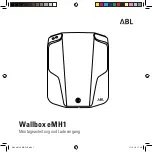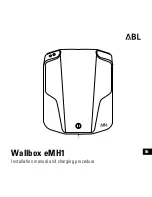
outside air temperature is monitored and displayed
by the Compass/Temp Mirror.
The ambient temperature sensor cannot be ad-
justed or repaired and, if faulty or damaged, it must
be replaced.
OPERATION
The resistance in the ambient temperature sen-
sor changes as the outside temperature rises or
falls. The Compass/Temp Mirror senses the change
in reference voltage through the ambient tempera-
ture sensor resistor. Based on the resistance of the
ambient temperature sensor, the Compass/Temp
Mirror module is programmed to correspond to a
specific temperature. The Compass/Temp Mirror
then displays the corresponding outside tempera-
ture received from the sensor.
AMBIENT TEMPERATURE SENSOR
DIAGNOSTICS
The outside temperature function is supported by
the ambient temperature sensor, a signal and
ground circuit hardwired to the compass/temp mod-
ule, and the Compass/Temp Mirror display.
If the Compass/Temp Mirror display indicates
9
SC
9
, the ambient temperature sensor circuit is
shorted to ground.
If the Compass/Temp Mirror display indicates
9
OC
9
, the ambient temperature sensor circuit is
open.
The ambient temperature sensor can be diag-
nosed using the following Sensor Test. First, con-
firm that °C is not being mistaken for °F or vise-
versa. If the ambient temperature sensor and the
circuits are confirmed to be OK, but the tempera-
ture display is inoperative or incorrect, replace the
Compass/Temp Mirror.
AMBIENT TEMPERATURE SENSOR TEST
1. Turn the ignition OFF.
2. Disconnect and isolate the battery negative ca-
ble.
3. Disconnect the ambient temperature sensor har-
ness connector.
4. Measure the resistance of the ambient tempera-
ture sensor using the following values:
> 0° C (32° F) Sensor Resistance = 29.33 - 35.99
Kilohms
> 10° C (50° F) Sensor Resistance = 17.99 - 21.81
Kilohms
> 20° C (68° F) Sensor Resistance = 11.37 - 13.61
Kilohms
> 25° C (77° F) Sensor Resistance = 9.12 - 10.86
Kilohms
> 30° C (86° F) Sensor Resistance = 7.37 - 8.75
Kilohms
> 40° C (104° F) Sensor Resistance = 4.90 - 5.75
Kilohms
The sensor resistance should read between these
min/max values. If the resistance value is OK, refer
to the Wiring Diagrams to test the Signal and
Ground circuits. If the resistance values are not
OK, replace the Sensor.
MAP/READING LAMP OPERATION
The Map/Reading lamp feature uses LED (light
emitting diode) technology as its light source. The
driver and passenger map lamps each consist of 6
LED’s, 2 blue-green and 4 amber. By mixing these
colors through the use of a diffusing cover the
output light is white in appearance. Direct viewing
of the LED’s will appear as blue-green and amber.
The lights are activated by the door switch when
entering or exiting the vehicle or manually by using
the appropriate button on the mirror as described
above. LED’s last 10-15+ years and are not designed
to be replaced in this application.
3.4
ELECTRICALLY HEATED SYSTEMS
3.4.1
REAR WINDOW DEFOGGER
The timing circuit for the Rear Window Defogger
is contained internally within the cluster. When the
ignition is on, the first actuation of the Rear Win-
dow Defogger switch initiates a 10 (ten) minute
time cycle. After 10 (ten) minutes of the same
ignition cycle has elapsed, the cluster will turn the
defogger off by opening the ground to the Rear
Window Defogger Relay. If the defogger switch is
actuated a second time during the same ignition
cycle, the cluster will turn the defogger off after 5
(five) minutes. While the defogger is on, depressing
the switch a second time will turn the defogger off.
If the ignition is turned off while the defogger is
operating, the defogger will remain off when the
ignition is cycled.
3.5
ELECTRO/MECHANICAL INSTRUMENT
CLUSTER (EMIC)
3.5.1
SMART CLUSTER FEATURES
The
Electro/Mechanical
Instrument
Cluster
(EMIC) houses the Fuel, Voltmeter, Engine Coolant
Temp, and Oil Pressure gauges, the Speedometer
and the Tachometer. The cluster positions the ana-
log gauges using PCI Bus messages received from
the PCM. The cluster also contains warning indica-
tors as well as indicators for the Right and Left turn
signals and the High Beam headlamps. Some of the
7
GENERAL INFORMATION
Summary of Contents for Wrangler TJ 2006
Page 6: ...NOTES vi...
Page 19: ...7 0 DIAGNOSTIC INFORMATION AND PROCEDURES 13...
Page 184: ...NOTES 178...
Page 192: ...C O N N E C T O R P I N O U T S 186 CONNECTOR PINOUTS...
Page 197: ...C O N N E C T O R P I N O U T S 191 CONNECTOR PINOUTS...
Page 204: ...NOTES 198...
Page 207: ...10 2 2 PREMIUM AUDIO SYSTEM S C H E M A T I C D I A G R A M S 201 SCHEMATIC DIAGRAMS...
Page 208: ...10 2 3 SATELLITE RADIO SDAR S C H E M A T I C D I A G R A M S 202 SCHEMATIC DIAGRAMS...
Page 210: ...10 5 INSTRUMENT CLUSTER S C H E M A T I C D I A G R A M S 204 SCHEMATIC DIAGRAMS...
Page 212: ...10 6 INTERIOR LIGHTING S C H E M A T I C D I A G R A M S 206 SCHEMATIC DIAGRAMS...
Page 213: ...10 7 REAR DEFOGGER S C H E M A T I C D I A G R A M S 207 SCHEMATIC DIAGRAMS...
Page 214: ...10 8 VEHICLE COMMUNICATIONS S C H E M A T I C D I A G R A M S 208 SCHEMATIC DIAGRAMS...
Page 216: ...Dealer Technical Operations 800 Chrysler Drive CIMS 486 02 76 Auburn Hills MI 48326 2757...














































